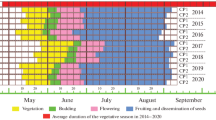Abstract
Two population characteristics, reproductive allocation (RA) and the intensity of photosynthesis, were investigated in the successional stages of the sandy grassland communities of the Great Hungarian Plain. Most of the species studied changed their allocational response as succession advanced. Compound path schemes, as casual models, were constructed and analysed for describing intra-individual effects (influence of assimilating organs and root mass of the plant sampled) as well as the phytosociological effects on RA. In pioneer stages, the high values of path coefficients show that the effect of assimilating organs is responsible for the variability of RA. It is also shown that annuals and perennials exhibit different behaviour as to the regulation of RA. It seems that-in terms of path analysis-the reproduction of annuals is influenced by internal factors only. In case of perennials, an external (namely phytosociological) regulation was also observed. It is suggested that successional stages play a role in regulating the photosynthetic intensity of both the dominant species and the whole plant assemblage.
Similar content being viewed by others
Abbreviations
- RA =:
-
Reproductive Allocation
References
Abrahamson W. G. 1979. Patterns of resource allocation in wild-flower populations of fields and woods. Amer. J. Bot. 66: 71–79.
Abrahamson W. G. & Gadgil M. D. 1973. Growth form and reproductive effort in goldenrods (Solidago, Compositae). Am. Nat. 107: 651–661.
Bazzaz F. A. 1979. The physiological ecology of plant succession. Ann. Rev. Ecol. Syst. 10: 351–371.
Bazzaz F. A. & Carlson R. W. 1982. Photosynthetic acclimatisation to variability in the light environment of early and late successional plants. Oecologia (Berlin) 54: 313–316.
Brown V. K. & Southwood T. R. E. 1987. Secondary succession: patterns and strategies. In: Gray A. J., Crawley M. J. & Edwards P. J. (eds), Colonization, succession and stability, pp. 315–337. Blackwell, Oxford.
Cody M. L. 1966. A general theory of clutch size. Evolution 20: 174–184.
Connell J. H. & Slatyer R. O. 1977. Mechanisms of succession in natural communities and their role in community stability and organization. Am. Nat. 111: 1119–1144.
Drury W. H. & Nisbet I. C. T. 1973. Succession. J. Arn. Arb. 54: 331–368.
Fekete G. 1985. A terresztris vegetáció szukcessziója: elméletek, modellek, valóság (Succession of terrestrial vegetation: theories, models, reality). In: Fekete G. (ed.), A cönológiai szukcesszió kérdései (Problems of coenological succession), pp. 31–63. Akadémiai Kiadó, Budapest.
Fekete G. & Melkó E. 1981. Reproductive allocation in the stages of sandy succession. Acta Bot. Hung. 27: 351–364.
Fekete G. & Tuba Z., 1982. Photosynthetic activity in the stages of sandy succession. Acta Bot. Hung. 28: 291–296.
Gaines M. S., Vogt K. J., Hamrick J. L. & Caldwell J. 1974. Reproductive strategies and growth patterns in sunflower (Helianthus). Am. Nat. 108: 889–894.
Grace J. B. & Wetzel R. G. 1981. Phenotypic and genotypic components of growth and reproduction in Typha latifolia: experimental studies in marshes of differing successional maturity. Ecology 62: 789–801.
Gray A. J. 1987. Genetic change during succession in plants. In: Gray A. J., Crawley M. J. & Edwards P. J. (eds), Colonization, succession and stability, pp. 273–293. Blackwell, Oxford.
Hargitai L. 1940. Nagykörös növényvilága II. A homoki növényszövetkezetek (Plant life in Nagykörös II. The plant communities on sand). Bot. Közl. 37: 205–240.
Harper J. L. & Ogden J. 1970. The reproductive strategy of higher plants. I. The concept of strategy with special reference to Senecio vulgaris. J. Ecol. 58: 681–698.
Hermy M. 1987. Path analysis of standing crop and environmental variables in the field layer of two Belgian riverine forests. Vegetatio 70: 127–134.
Le Roy H. L. 1960. Statistische Methoden der Populationsgenetik. Birkhauser, Basel.
Li C. C. 1955. Population genetics. Univ. of Chicago Press, Chicago.
Luftensteiner H. W. 1980. Der Reproduktionsaufwand in vier Mitteleuropäischen Pflanzengemeinschaften. Pl. Syst. Evol. 135: 235–251.
Melkó E. 1984. Reproductive allocation in the stages of sandy succession II. Acta Bot. Hung. 30: 129–137.
Newell S. J. & Tramer E. J. 1978. Reproductive strategies in herbaceous plant communities during succession. Ecology 59: 228–234.
Noble I. R. & Slatyer R. O. 1980. The use of vital attributes to predict successional changes in plant communities subject to recurrent disturbances. Vegetatio 43: 5–21.
Reekie E. G. & Bazzaz F. A. 1987a. Reproductive effort in plants. 1. Carbon allocation to reproduction. Am. Nat. 129: 876–896.
Reekie E. G. & Bazzaz F. A. 1987b. Reproductive effort in plants. 3. Effect of reproduction on vegetative activity. Am. Nat. 129: 907–919.
Ross F. H. & Quinn J. A. 1977. Phenology and reproductive allocation in Andropogon scoparius (Gramineae) populations in communities of different successional stages. Am. J. Bot. 64: 535–540.
Scheiner S. M. & Goodnight C. J. 1984. A comparison of phenotypic plasticity and genetic variation in populations of the grass Danthonia spicata. Evolution 38: 845–855.
Stewart A. J. A. & Thompson K. 1982. Reproductive strategies of six herbaceous perennial species in relation to a successional sequence. Oecologia Berl. 52: 269–272.
Szodfridt I. 1969. Borókás-nyárasok Bugac környékén (Juniperpoplar stands in the environs of Bugac). Bot. Közl. 56: 159–165.
Wright S. 1921. Correlation and causation. J. Agr. Res. 20: 557–585.
Wright S. 1934. The method of path coefficients. Ann. Math. Stat. 5: 161–215.
Author information
Authors and Affiliations
Rights and permissions
About this article
Cite this article
Fekete, G., Tuba, Z. & Melkó, E. Background processes at the population level during succession in grasslands on sand. Vegetatio 77, 33–41 (1988). https://doi.org/10.1007/BF00045747
Accepted:
Issue Date:
DOI: https://doi.org/10.1007/BF00045747




